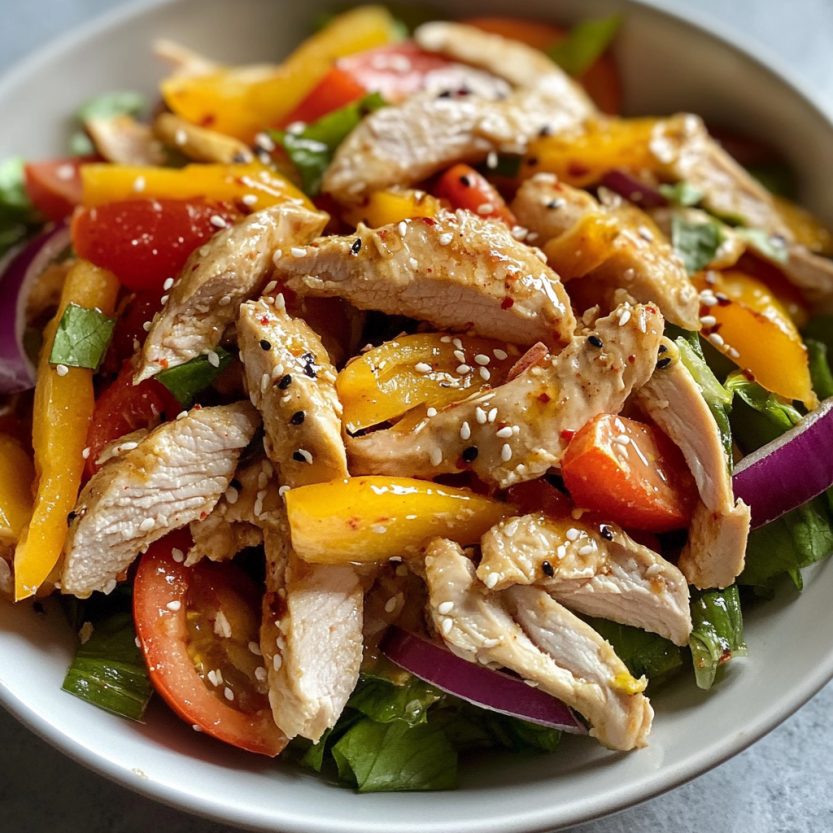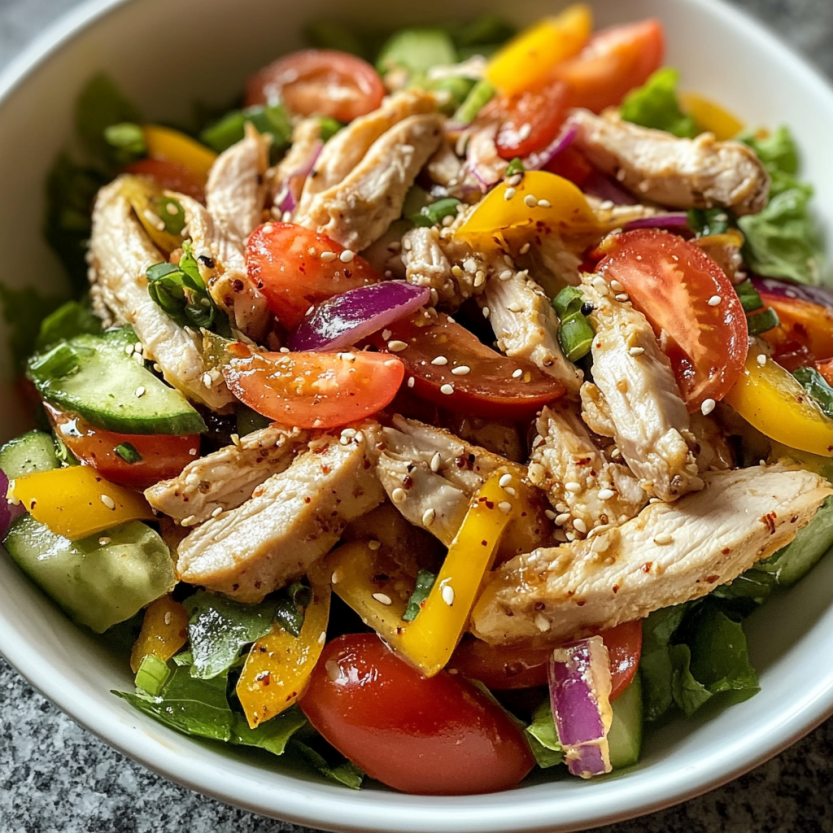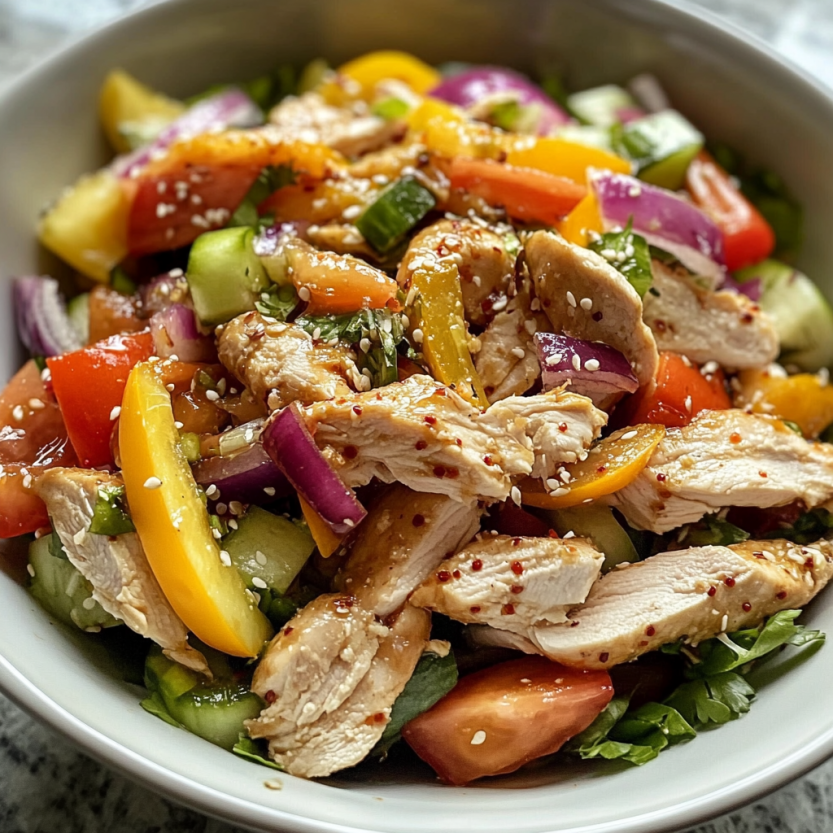 Save
Save
Dak Naengchae celebrates the rhythm of summer meals in my kitchen bright cool and vibrant from first glance to last bite. This Korean cold chicken salad is perfect when you crave something refreshing yet hearty and its medley of crisp vegetables tender chicken and sweet-tangy mustard dressing has become my favorite warm-weather lunch for a crowd.
When my kids first eyed the mango slices in their salad bowls I braced for complaints but the unexpected sweetness made them fans for life. Now we make it together especially when we want to eat something cold and cheerful outside on the porch.
Ingredients
- Scallion: adds savory depth and a gentle onion note pick one that is firm and bright green
- Garlic: intensifies the savoriness and adds warmth use fresh cloves for best flavor
- Ginger: optional but boosts the broth with subtle zing choose a piece that feels heavy and has smooth skin
- Boneless skinless chicken breasts: lean and tender try to source organic or free-range for even better texture
- Black peppercorns: add mellow heat and aroma whole peppercorns lend a gentle flavor without overpowering
- Honey: natural sweetness that balances the tang use good quality honey for pure clean taste
- Rice vinegar or apple cider vinegar: provides brightness and acidity quality vinegar brings a gentle tang instead of harsh sharpness
- Toasted white sesame seeds: nutty crunch and aroma lightly toast them yourself for maximum fragrance
- Korean hot spicy yellow mustard such as Chung Jung On: adds an essential signature bite bright mustardy and uniquely floral
- Toasted sesame oil: rounds out the flavors with nutty depth always go for toasted for the richest aroma
- Kosher salt: for seasoning larger flakes mean you can control the saltiness more easily
- Red onion: brings sweetness and crunch slice thin to mellow the bite and soak in vinegar to further soften flavor
- Red bell pepper: sweet and crisp look for tight glossy skin
- Yellow bell pepper: mellower than red and adds more color to the salad also pick one that feels heavy for its size
- English cucumber: refreshing and nearly seedless no need to peel unless the skin is tough
- Mango: the surprise star for juicy sweetness and bright color ripe yet still firm mango works best so it slices well
Step-by-Step Instructions
- Prepare the Aromatics:
- Peel the garlic cloves and the ginger if you are using it. Trim the scallion and cut it in half crosswise. Place these into a medium saucepan.
- Cook the Chicken:
- Add the chicken breasts and black peppercorns to the saucepan. Pour in enough cool water to cover the chicken by about an inch. Set the pan over medium-high heat and bring to a boil then lower the heat to maintain a gentle simmer. Cover with a lid and let it cook for about fifteen minutes or until the thickest part of the chicken reaches a safe temperature and is no longer pink inside.
- Cool and Rinse the Chicken:
- Turn off the heat. Carefully pour the contents of the pan through a mesh strainer set in the sink. Rinse the chicken under cold water to cool it slightly and remove any flavor from the aromatics. Return the chicken to the empty saucepan and add enough cold water to just cover it which chills it further.
- Make the Dressing:
- Finely mince the remaining garlic clove and transfer it to a small bowl. Add the honey toasted sesame seeds two tablespoons of the vinegar mustard sesame oil and kosher salt. Whisk everything together thoroughly until the honey is dissolved and everything looks creamy and well blended.
- Prep the Red Onion:
- Fill a medium bowl with ice cubes and water then add the remaining tablespoon of vinegar. Halve and thinly slice the red onion and let it soak in the cold water-vinegar bath. This takes away sharpness and keeps the slices crisp.
- Cut and Combine the Vegetables:
- Slice the red and yellow bell peppers into thin strips after removing seeds and cores. Peel the cucumber halve it lengthwise and use a spoon to scrape out the watery center then cut into long thin matchsticks. Peel the mango slice from the pit in large sections then cut into thin strips.
- Build the Salad:
- Pat the soaked red onion dry with paper towels. Shred the chilled chicken breasts into bite-sized pieces using your hands or two forks. Place all the prepared vegetables mango and chicken in a large mixing bowl. Pour the dressing over everything and toss gently so all the ingredients are evenly coated.
- Finish and Serve:
- Heap the salad onto a platter or individual bowls. Sprinkle more toasted sesame seeds over the top for extra crunch and nutty flavor. Serve immediately while cold for maximum refreshment.
 Save
Save
I always look forward to those first bites of mango in Dak Naengchae the juicy sweetness against spicy mustard and nutty sesame is unforgettable. My daughter now asks for this salad as her birthday lunch every year and it has become a symbol of our family’s summer gatherings.
Storage Tips
Dak Naengchae stores well in an airtight container in the refrigerator for up to three days. If possible reserve a little extra dressing and sesame seeds to freshen up leftovers before serving. For the crispest texture assemble the salad just before eating but you can prep the chicken vegetables and dressing up to a day earlier.
Ingredient Substitutions
If you cannot find Korean spicy mustard try using Dijon or Chinese hot mustard for a similar kick. Apple cider vinegar can be swapped for rice vinegar if needed. Any ripe but firm stone fruit like peach can stand in for mango though mango brings the most authentic sweet flavor. Feel free to use poached or rotisserie chicken for even faster prep.
Serving Suggestions
Enjoy Dak Naengchae as a light meal on its own or pair with steamed sticky rice and kimchi for a more filling spread. I sometimes serve it in lettuce cups for easy picnic finger food and it always gets rave reviews at potlucks. Sprinkle a few extra herbs like mint or cilantro on top for an added layer of freshness.
 Save
Save
Cultural Context
Dak Naengchae originated as a festive cold salad in Korea often found in celebratory feasts and banquets. Its bright colors and refreshing qualities make it a sought-after specialty during warm months. The peppery mustard dressing offers a distinctly Korean twist that wakes up the palate and turns simple ingredients into something extraordinary.
Recipe Questions
- → What type of chicken works best?
Boneless, skinless chicken breasts are preferred for their tenderness and mild flavor after poaching.
- → Can I substitute the Korean mustard?
If Korean hot mustard is unavailable, Dijon mustard mixed with a pinch of chili powder offers a similar kick.
- → How do I keep the vegetables crisp?
Slice vegetables thinly and add them just before serving. An ice bath for onions adds extra crunch.
- → Is this dish served cold?
Yes, the cooked chicken is rinsed in cold water and combined with chilled vegetables for serving.
- → How should leftovers be stored?
Keep leftovers in an airtight container in the refrigerator. Best enjoyed within 3 days.
- → Can the dressing be prepared ahead?
Yes, the sesame mustard dressing can be made two days in advance and stored sealed in the fridge.